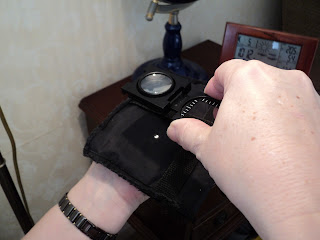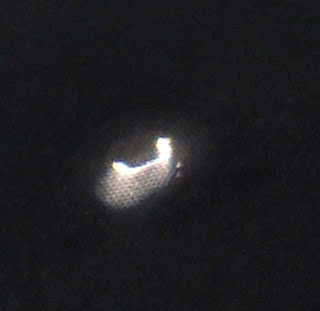Here's a question I would put to those scientists. OK, so it may have been ultraviolet light that produced the image on the linen. But have you not forgotten something? To form an image requires not just a source of radiation. It requires a means of bringing rays to a focus (think converging lens, or concave mirror, or even a simple pinhole camera). How would a burst of uv light be able to produce an image without that necessary adjunct - a focusing device?
Reminder: here's a short series of pictures that I took a few minutes ago:
Here's a black surface (my camera case) being held under a standard lamp, emitting visible white light, with nothing except soft diffused light, certainly no image of the source of light.
Interpose a converging lens, aka "burning glass", and one sees the familiar spot of concentrated (focused) light. Let's now take a closer look.
Can you see what it is yet?
Ah, that's better. Looks a bit embryo-like. Have you guessed what it is (assuming you do not already know?)
I'll try doing an enlargement (update: result below). In the meantime, please take my word that it is an image of the incandescent filament in the lamp. But there was no visible image of that filament until the lens was interposed. (If you know your optics, and recall the means by which the pinhole camera works, you will know that an illuminated object does in fact cast images of itself on every surface with which those rays subsequently come into contact, but note the plural - images. Without a lens or single pinhole there is a multiplicity of overlapping images, such that all one sees is a patch of suffused light.
The conclusion should be obvious, even from this GCSE-level experiment: a source of radiation on its own, even a gee-whizz uv source that can allegedly leave a signature of its source on fabric - is no use on its own without some means of focusing the rays to form a single sharp image.
Yup, it's the filament. You can just about make out the helical turns of tungsten filament.
























No comments:
Post a Comment